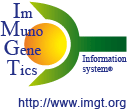IMGT unique numbering for C-DOMAIN and C-LIKE-DOMAIN
Lefranc, M.-P. et al., Dev. Comp. Immunol., 29, 185-203 (2005) PMID: 15572068
- IMGT unique numbering for C-DOMAIN
- IMGT unique numbering for C-LIKE-DOMAIN
- Range of strand, turn and loop lengths in C-DOMAIN and C-LIKE-DOMAIN
- Detailed rules
- Gaps and additional position rules for FG-LOOP
- Correspondence between the IMGT unique numbering for C-DOMAIN, the IMGT exon numbering, the Eu and Kabat numberings: Human IGHG
- Correspondence between the IMGT unique numbering for C-DOMAIN, the IMGT exon numbering, the Eu and Kabat numberings: Human IGKC
- Correspondence between the IMGT unique numbering for C-DOMAIN, the IMGT exon numbering and the Kabat numberings: Human IGLC
'IMGT Protein display for C domain' header:
![]()

IMGT unique numbering for C-DOMAIN
The C-DOMAIN corresponds to the complete C-REGION, to most of the C-REGION or to only part of the C-REGION, depending on the immunoglobulin (IG) or T cell receptor (TR) chain type.
The IMGT numbering for C-DOMAIN (IG and TR) [1] is derived as the IMGT unique numbering for V-DOMAIN [2], from the princeps IMGT unique numbering for V-REGION, up to position 104. Positions 105 to 128 were defined by comparing C-DOMAIN and V-DOMAIN [2]. Amino acid positions can therefore be easily compared between the C-DOMAIN and the V-DOMAIN[1].
Amino acid positions shown on the upper line in the Protein displays correspond to equivalent positions in the V-DOMAIN. The correspondence was established by sequence alignment comparison and structural data analysis (Ruiz M., Martinez-Jean C and Lefranc M.-P. IMGT on-line, 27/02/2001). Amino acid positions on the lower line are characteristic of the C-DOMAIN.
We can distinguish:
-
Structurally equivalent amino acid positions between the C-DOMAIN and the V-DOMAIN
Seventy-two positions are structurally equivalent between the C-DOMAIN and the V-DOMAIN, when the strands A to G are compared. They comprise: positions 1-15 (strand A), 16-26 (strand B), 39-45 (strand C), 77-84 (strand D), 85-96 (strand E), 97-104 (strand F), 118-128 (strand G).
-
Additional amino acid positions in the C-DOMAIN compared to the V-DOMAIN
Thirty-four positions are characteristic of the C-DOMAIN numbering. The positions of these additional positions compared to the V-DOMAIN are designated by a number followed by a dot and a number :
- 1.1 to 1.8 at the N-terminal end of the C-DOMAIN
- 15.1 to 15.3 at the AB turn
- 45.1 to 45.7 at the CD turn which represent a characteristic transversal strand CD
- 84.1 to 84.7, 85.7 to 85.1 at the DE turn. These positions correspond to longer antiparallel D and E strands in the C-DOMAIN
- 96.1 and 96.2 at the EF turn.
-
Missing amino acid positions in the C-DOMAIN compared to the V-DOMAIN
Thirty-three positions are missing in the C-DOMAIN compared to the V-DOMAIN:
- The positions 32 and 33 are missing in the C-DOMAIN BC loop. The C-DOMAIN BC loop has a maximum length of 10 amino acids (positions 27-31, 34-38) compared to the maximum length of 12 amino acids for the equivalent V-REGION CDR2-IMGT. Unusual additional amino acid positions are indicated with a letter.
The positions 46 to 76 are missing in the C-DOMAIN, compared to the V-DOMAIN which has two additional strands C' and C''.
-
Structural different amino acid positions between the C-DOMAIN and the V-DOMAIN
Positions 45.1 to 45.9 are structurally different between the C-DOMAIN and the V-DOMAIN. Indeed these positions represent a transversal strand between C and D in the C-DOMAIN whereas, in contrast, there are two additional C' and C'' strands in the V-DOMAIN.
-
Gaps and additional positions of the FG-LOOP in the C-DOMAIN
The positions of the FG-LOOP in the C-DOMAIN follow those of the V-DOMAIN CDR3-IMGT.
Gaps for FG-LOOP length less than 13 amino acids are created from the top of the loop, in the following order 111, 112, 110, 113, 109, 114, etc. Additional positions for FG-LOOP length more than 13 amino acids are created between positions 111 and 112 at the top of the FG loop in the following order 112.1,111.1, 112.2, 111.2, 112.3, 111.3, etc. See tables below in Detailed rules.
IMGT unique numbering for C-LIKE-DOMAIN
The C-LIKE-DOMAIN corresponds to a domain of similar structure as C-DOMAIN, found in chains other than IG or TR.
The IMGT unique numbering for C-LIKE-DOMAIN (proteins other than IG or TR) follows exactly the same rules are those of the C-DOMAIN.
The IMGT unique numbering for the C-LIKE-DOMAIN and V-LIKE-DOMAIN allows, for the first time, to compare any C-LIKE-DOMAIN and V-LIKE-DOMAIN of any protein of the immunoglobulin superfamily (IgSF).
Range of strand, turn and loop lengths in C-DOMAIN and C-LIKE-DOMAIN
The range of the strand, turn and loop lengths from 51 selected examples of C-DOMAIN and C-LIKE-DOMAIN [1] is indicated between parentheses. The total length of the domain is between 85 and 110 amino acids for 46 of the 51 examples [1]. Start and end positions of the A, B, C, CD, D, E, F and G strands, of the AB, DE and EF turns, and of the BC and FG loops are according to [1].
| A strand |
AB turn |
B strand |
BC loop |
C strand |
CD strand |
D strand |
DE turn |
E strand |
EF turn |
F strand |
FG loop |
G strand |
Total length |
|---|---|---|---|---|---|---|---|---|---|---|---|---|---|
| 1.8-1.1, 1-15 |
15.1-15.3 | 16-26 | 27-38 | 39-45 | 45.1-45.7 | 77-84 | 84.1-84.7, 85.7-85.1 |
85-96 | 96.1-96.2 | 97-104 | 105-117, 111.1-111.6, 112.1-112.6 |
118-128 | |
| (6-23) | (0-2) | (7-11) | (4-10) | (7) | (0-7) | (4-8) | (0-14) | (8-12) | (0-2) | (4-8) | (7-25) | (4-10) | (67-129) |
Detailed rules
Gaps and additional position rules for FG-LOOP
These rules follow those of V-DOMAIN CDR3-IMGT.
The basic length of a FG-LOOP is 13 amino acids (positions 105 to 117).
If the FG-LOOP length is less than 13 amino acids, gaps are created from the top of the loop, in the following order 111, 112, 110, 113, 109, 114, etc.
| FG-LOOP lengths |
Gaps for FG-LOOP lengths < 13 amino acids | ||||||||||||
|---|---|---|---|---|---|---|---|---|---|---|---|---|---|
| 13 | 105 | 106 | 107 | 108 | 109 | 110 | 111 | 112 | 113 | 114 | 115 | 116 | 117 |
| 12 | 105 | 106 | 107 | 108 | 109 | 110 | - | 112 | 113 | 114 | 115 | 116 | 117 |
| 11 | 105 | 106 | 107 | 108 | 109 | 110 | - | - | 113 | 114 | 115 | 116 | 117 |
| 10 | 105 | 106 | 107 | 108 | 109 | - | - | - | 113 | 114 | 115 | 116 | 117 |
| 9 | 105 | 106 | 107 | 108 | 109 | - | - | - | - | 114 | 115 | 116 | 117 |
| 8 | 105 | 106 | 107 | 108 | - | - | - | - | - | 114 | 115 | 116 | 117 |
| 7 | 105 | 106 | 107 | 108 | - | - | - | - | - | - | 115 | 116 | 117 |
| 6 | 105 | 106 | 107 | - | - | - | - | - | - | - | 115 | 116 | 117 |
| 5 | 105 | 106 | 107 | - | - | - | - | - | - | - | - | 116 | 117 |
| --- | |||||||||||||
If the FG-LOOP length is more than 13 amino acids, additional positions are created between positions 111 and 112 at the top of the FG loop in the following order 112.1,111.1, 112.2, 111.2, 112.3, 111.3, etc.
| FG-LOOP lengths |
Additional positions between 111 and 112 for FG-LOOP lengths > 13 amino acids | |||||||||
|---|---|---|---|---|---|---|---|---|---|---|
| --- | ||||||||||
| 21 | 111 | 111.1 | 111.2 | 111.3 | 111.4 | 112.4 | 112.3 | 112.2 | 112.1 | 112 |
| 20 | 111 | 111.1 | 111.2 | 111.3 | - | 112.4 | 112.3 | 112.2 | 112.1 | 112 |
| 19 | 111 | 111.1 | 111.2 | 111.3 | - | - | 112.3 | 112.2 | 112.1 | 112 |
| 18 | 111 | 111.1 | 111.2 | - | - | - | 112.3 | 112.2 | 112.1 | 112 |
| 17 | 111 | 111.1 | 111.2 | - | - | - | - | 112.2 | 112.1 | 112 |
| 16 | 111 | 111.1 | - | - | - | - | - | 112.2 | 112.1 | 112 |
| 15 | 111 | 111.1 | - | - | - | - | - | - | 112.1 | 112 |
| 14 | 111 | - | - | - | - | - | - | - | 112.1 | 112 |
| [1] |
Lefranc, M.-P. et al., Dev. Comp. Immunol., 29, 185-203 (2005)
PMID: 15572068
LIGM:293
|
| [2] | Lefranc, M.-P. et al., Dev. Comp. Immunol., 27, 55-77 (2002) PMID: 12477501 LIGM:268 |
We thank Elsevier and Developmental and Comparative Immunology, for allowing IMGT to make available the DCI pdf file on the IMGT site.



